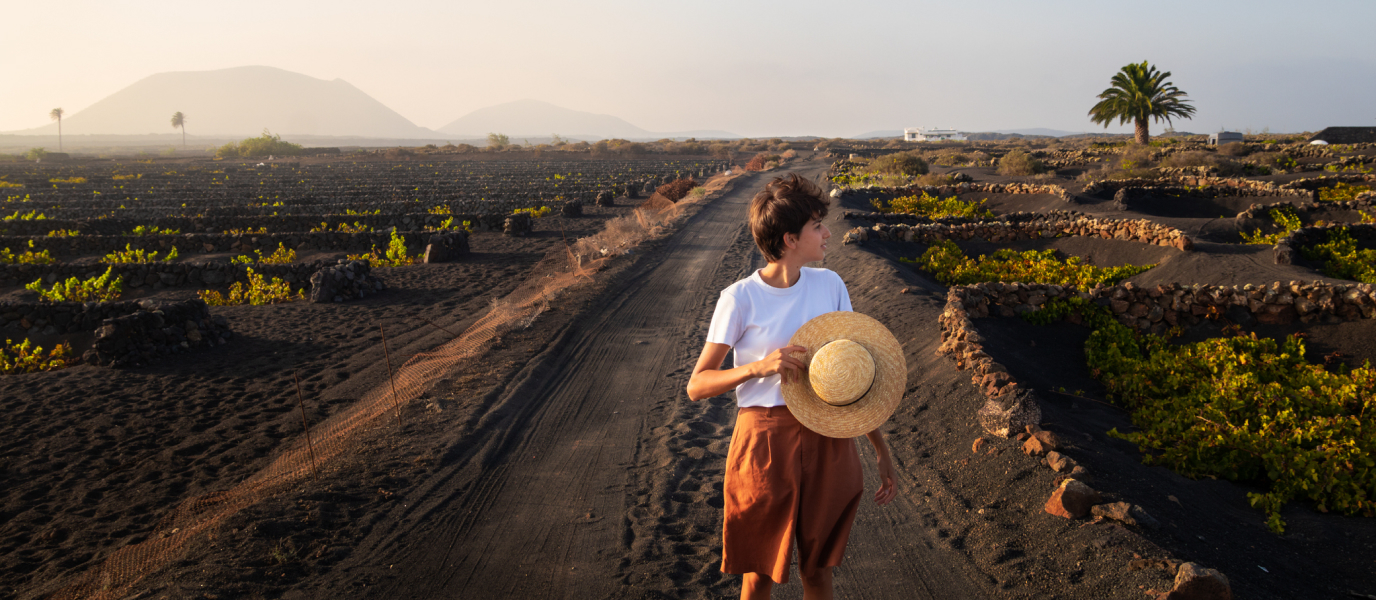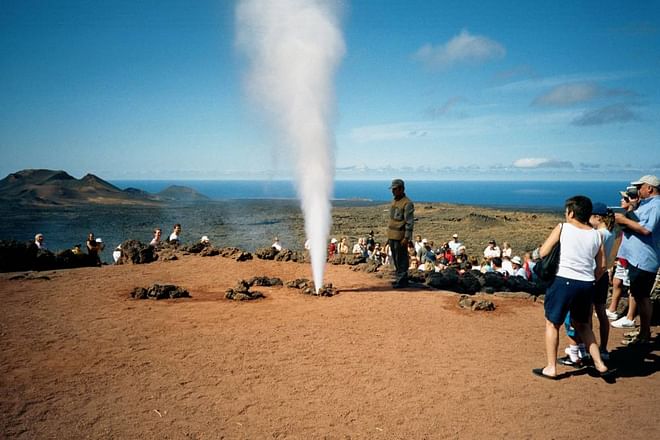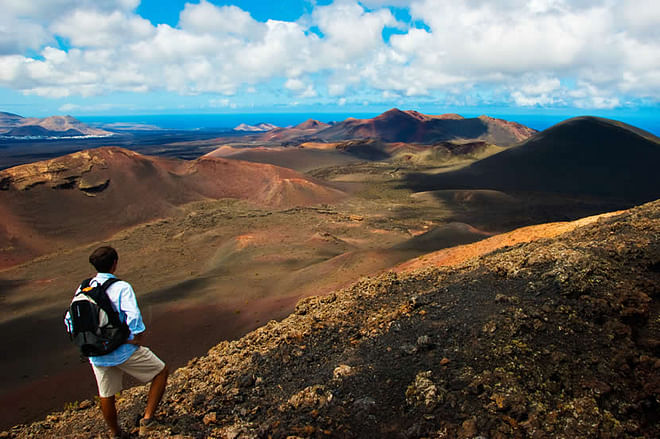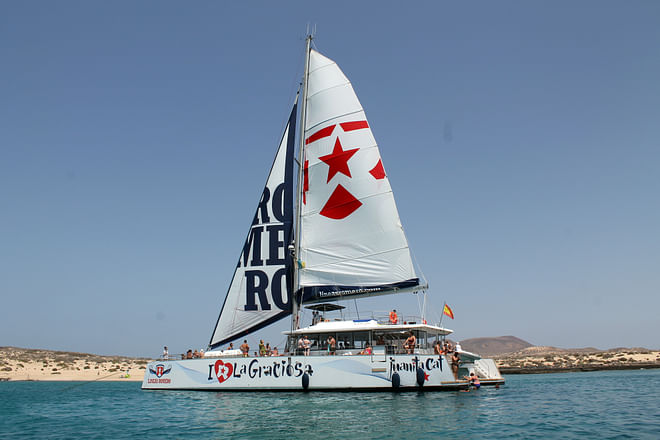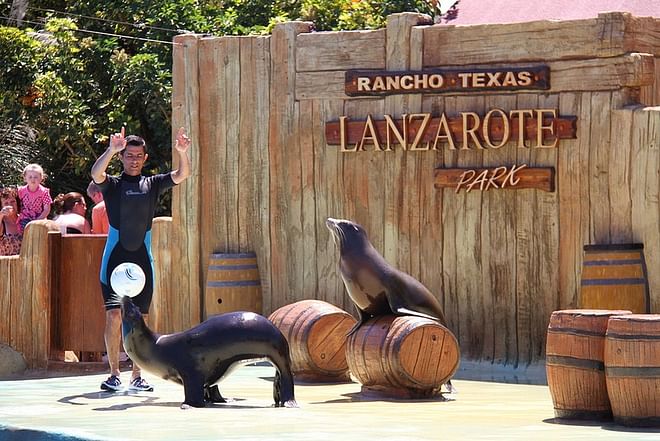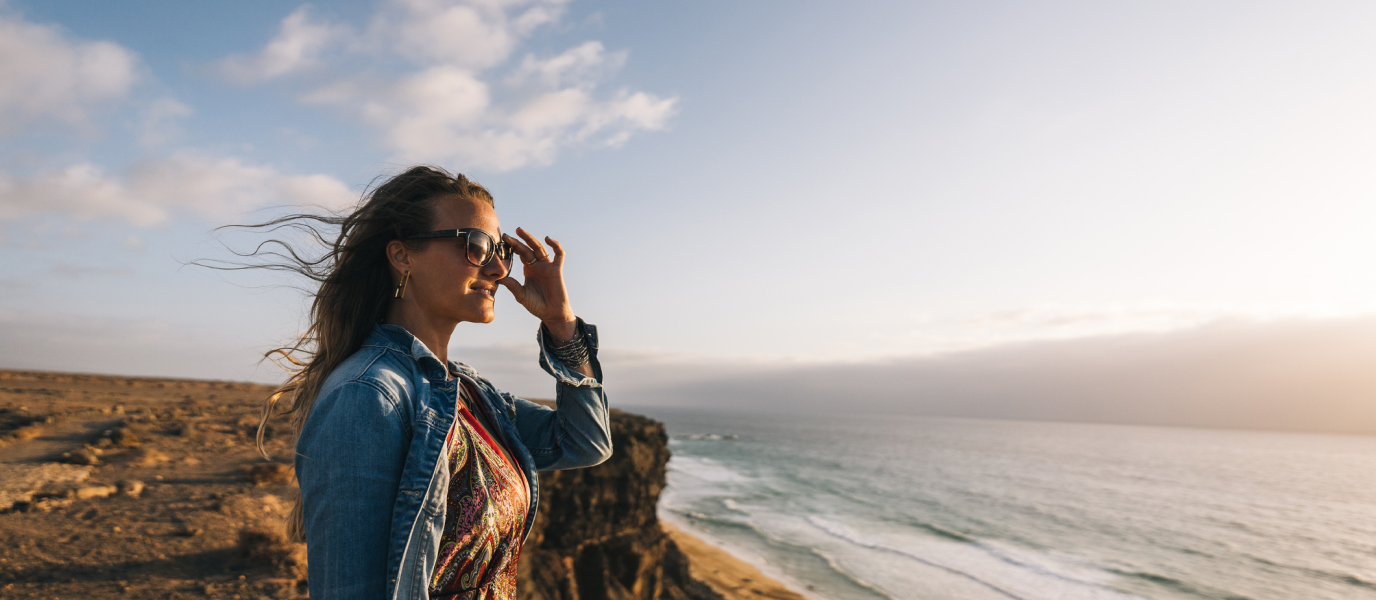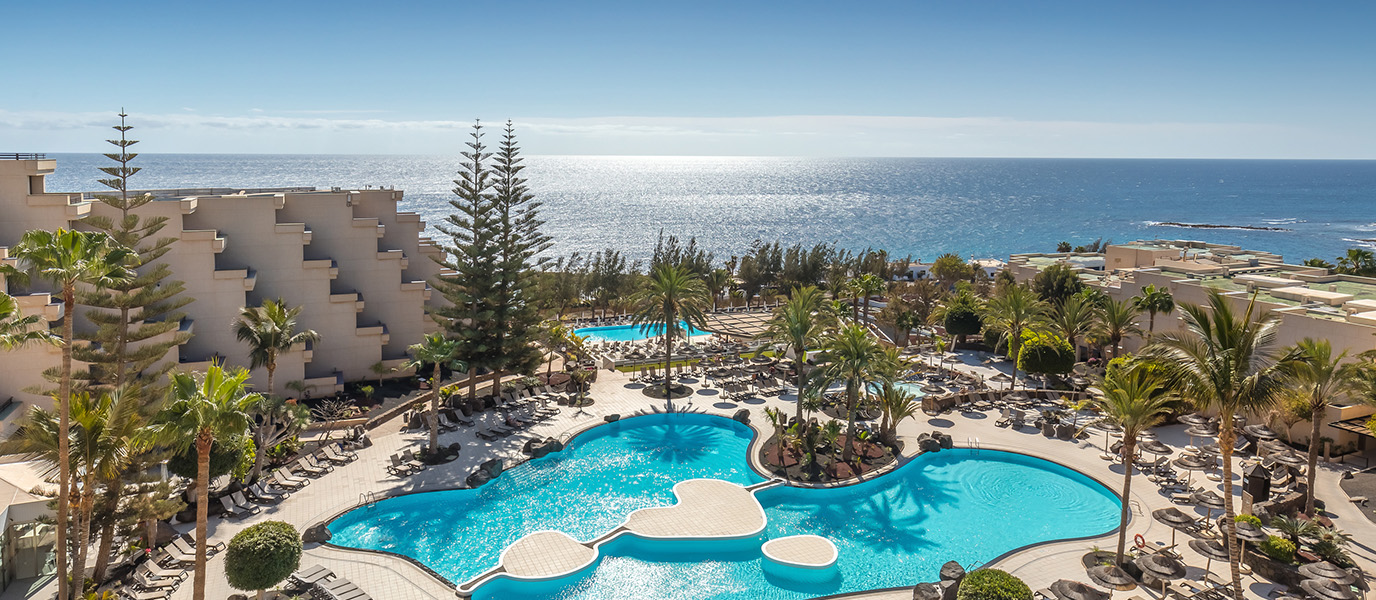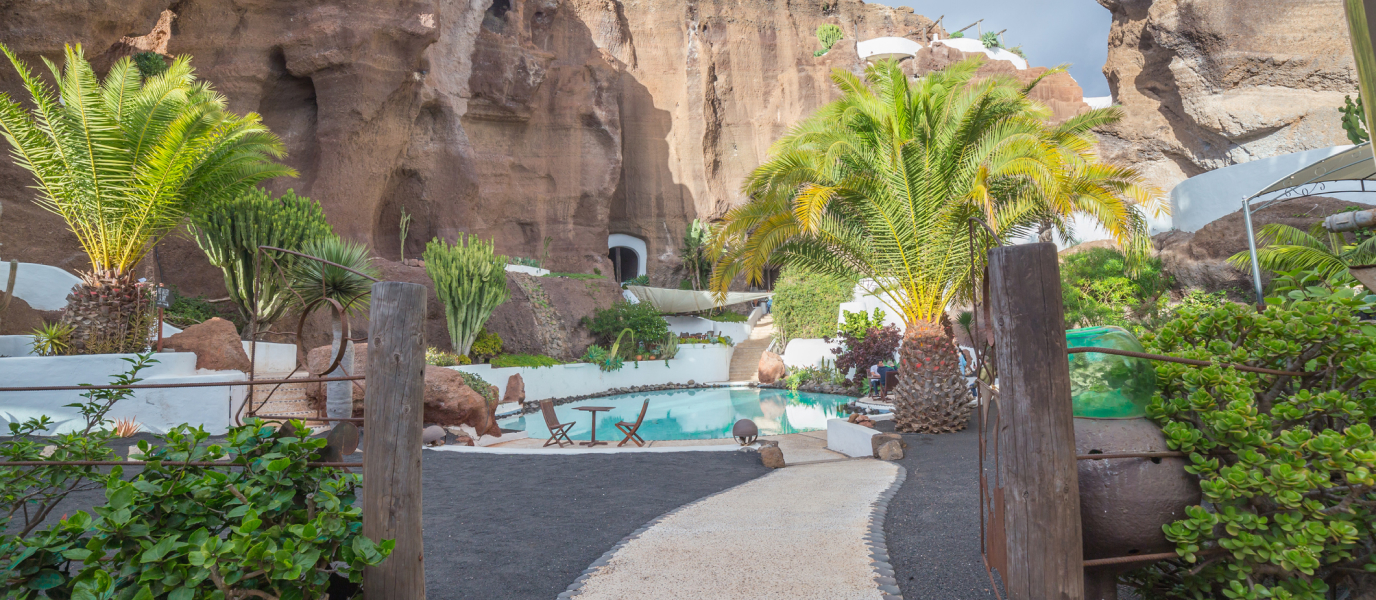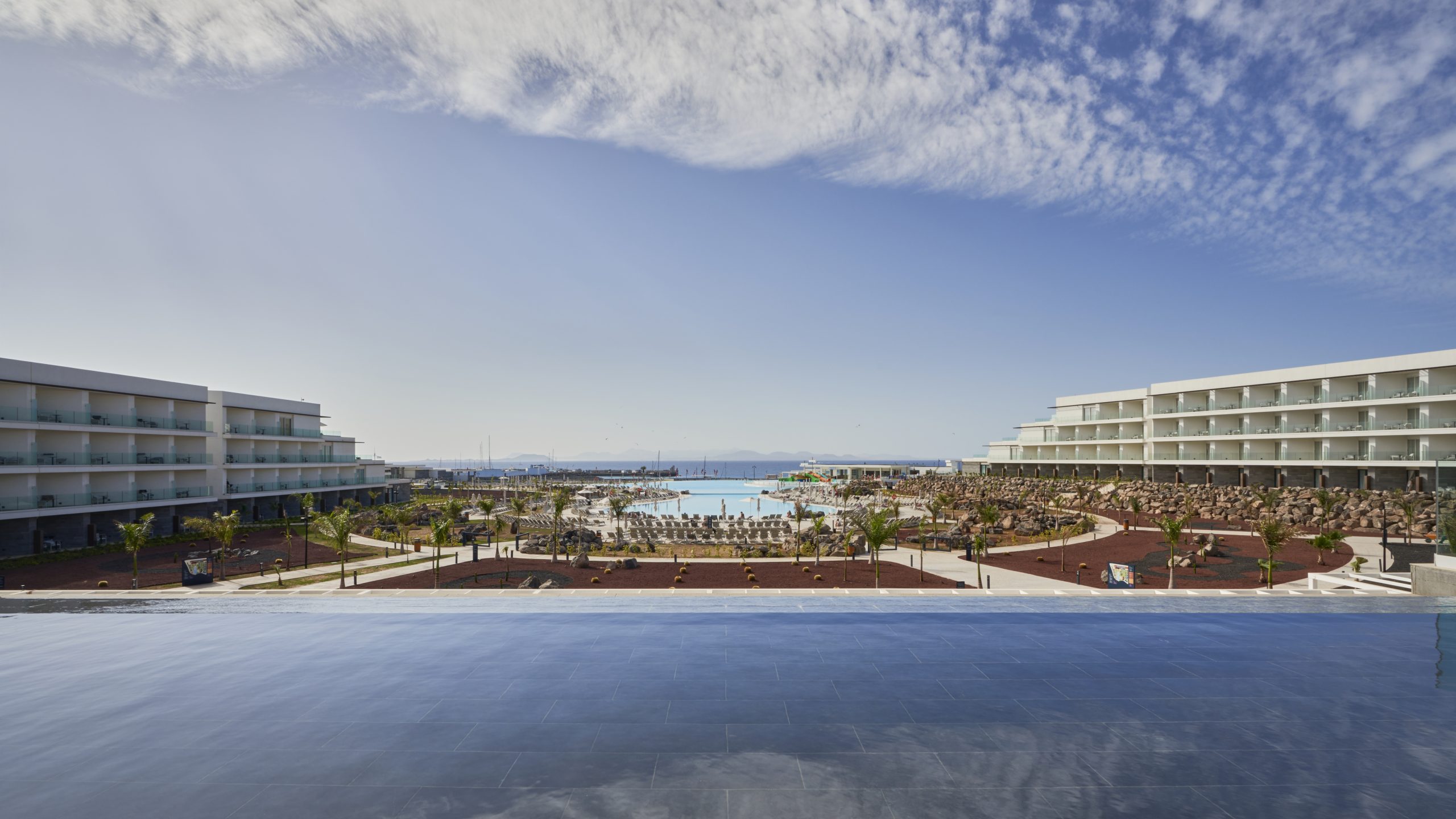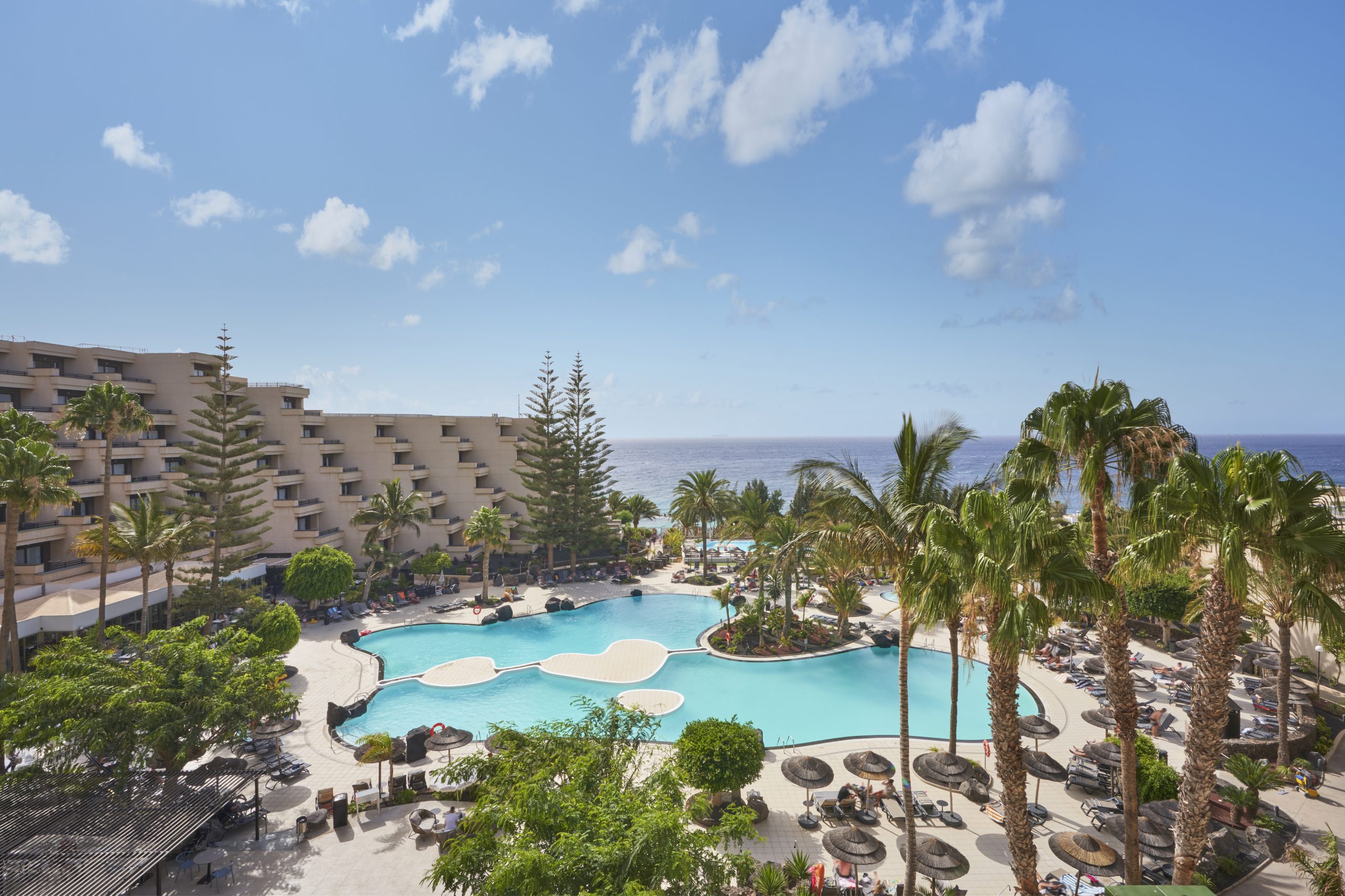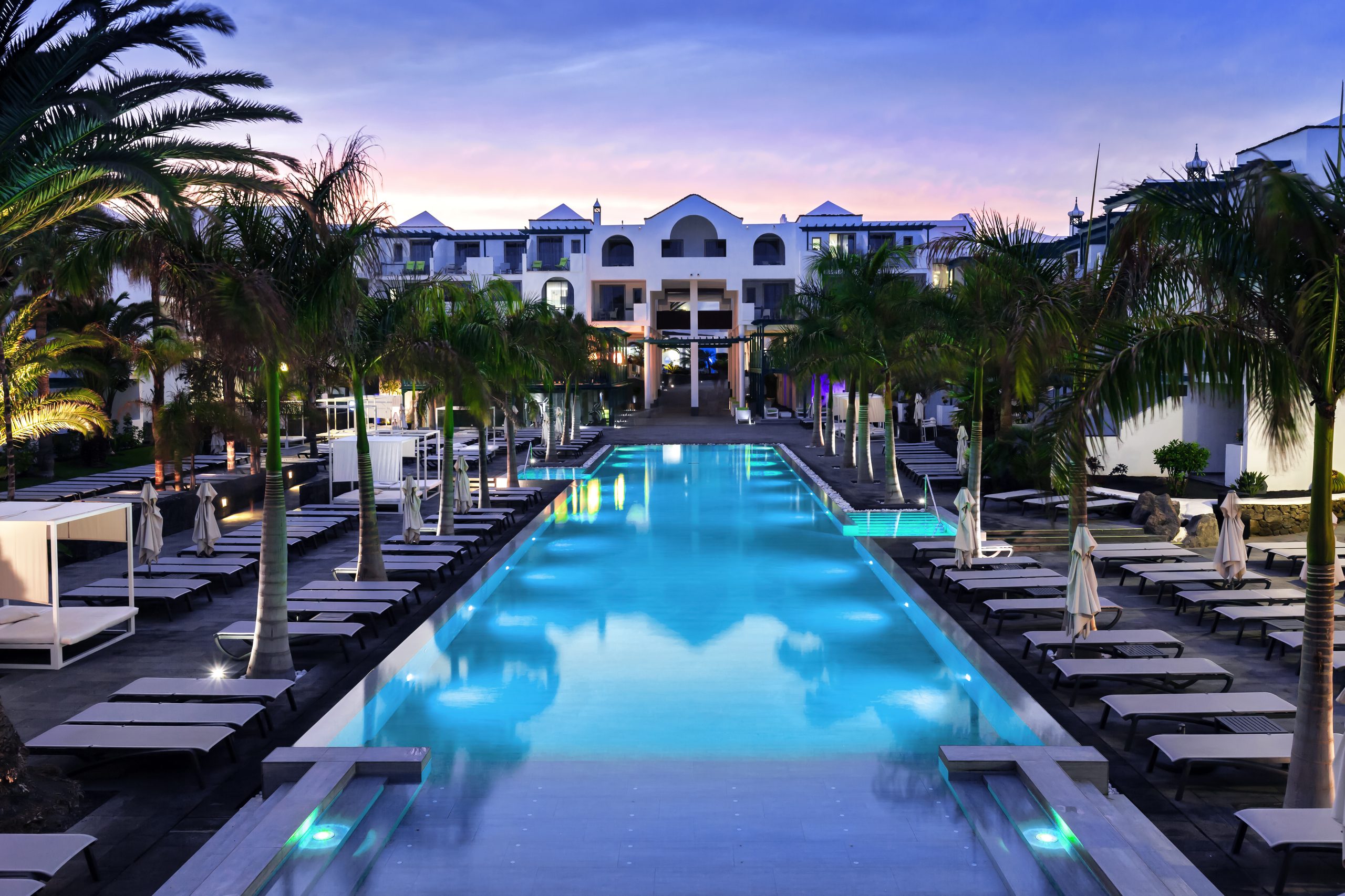We tell you what to see in Lanzarote on our journey around the Canary Islands.A tourist guide to accompany those on Tenerife, Gran Canaria and Fuerteventura.
Discover all you can do on this island that never fails to surprise. Lanzarote’s alien, powerful and enigmatic volcanic landscapes often give travellers the feeling of being on another planet. Travelling over the island’s 850 square kilometres of coast and lava fields is like discovering a new land.Even mass tourism has not obliterated its image as an unknown territory, an impression further heightened when visiting areas such as the Timanfaya National Park.
Visitors are captivated by the small, sister island of La Graciosa, and particularly by its breathtaking natural scenery. But Lanzarote has also been shaped by the hand of man — the artist César Manrique, a figure with the power to put the brakes on urban expansion. His respect for the environment and his capacity for integrating architecture into nature produced unforgettable attractions, including the Jameos del Agua, the Mirador del Río [River Viewing Point], and the Jardín de Cactus [Cactus Garden]. Examples of how something that is already beautiful can be made even more beautiful.
Places not to be missed in Lanzarote
Related experiences
Timanfaya, an out-of-this-world volcanic landscape
A remarkable landscape, like the surface of another planet, awaits travellers to Timanfaya. Montaña de Fuego, Montaña Rajada, the islet of Hilario, the Caldera del Corazoncillo, the Rodeos Mountains and the Señalo Mountains, Pico Partido, the Caldera de Rilla… These are just a few of the volcanic formations to be found in this large area of rough, barren lava flows in Lanzarote. A silent, transcendent landscape.
Timanfaya owes its unique landscape to volcanic activity that occurred between 1730 and 1736, when part of the island shuddered and was left covered in lava and glowing rock. As many as twelve villages were left buried beneath the ash. The high temperatures of the surface here remind us that below ground a magma chamber remains, a real heart of fire.
The area’s designation as a National Park in 1974, followed later by a declaration of over 90% of the land as a Reservation Area, has meant that it has remained virtually unspoilt. To find out all about it, your first step should be to call in at the Mancha Blanca Visitor and Interpretation Centre. Here, visitors can get in-depth information about this spectacular, volcanic park that stretches over more than 50 square kilometres. Although part of the park is protected, and therefore not open to visitors, there is still a great deal to see. In this sublime place, where the black of the landscape mingles with glowing ochre and red tones, you can visit places that are truly unforgettable.
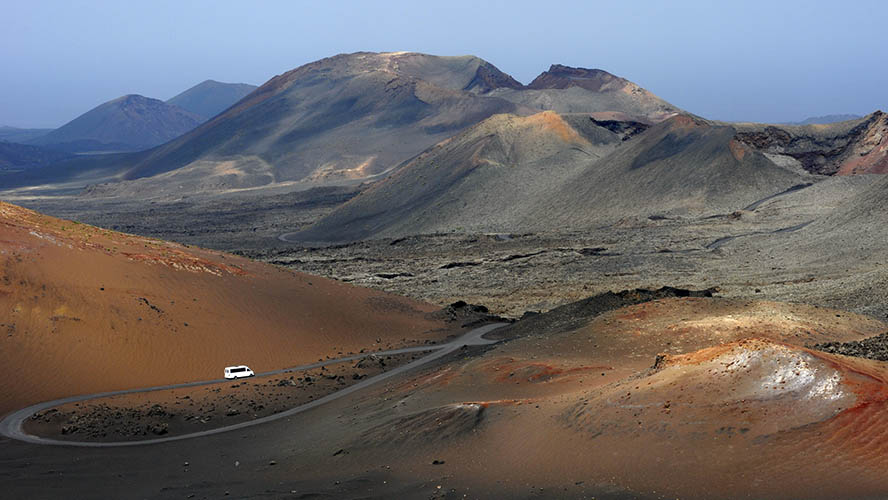
Hiking enthusiasts have a choice of trails through Timanfaya, but the simplest and most popular way to tour the area is on a guided bus tour. The forty-minute trip includes a volcano tour and a ride through volcanic tubes, and pyroclastic and lava fields. If you want to see more of these remarkable landscapes, there are other options, including the Tremesana tour, or the Coastline tour. While it is always advisable to undertake these tours with guides, the most competent hikers could attempt some of them independently. Camel tours are also extremely popular in the area. A perfect adventure activity for families with children.
Jameos del Agua, a journey to the centre of the Earth
The Jameos del Agua is a fascinating project by César Manrique. The artist is a constant presence in so many corners of the island. His architectural works, which are always mindful of the environment, are expertly integrated into the natural setting. In the case of the Jameos del Agua, Manrique played with the idea of a journey to the centre of the Earth. This is the impression that accompanies the visitor from the outset, even as he or she walks down the steps on the first stage. From that moment onwards, one jaw-dropping sight follows another.
Manrique’s starting point for this architectural attraction was his fascination with the volcanic tunnel formed after the eruption of the Volcán de la Corona. This tunnel, over 6 kilometres in length, extends from the crater of the volcano itself to the sea, and continues for a further kilometre and a half under the sea. The Jameos del Agua is the section of the tunnel that lies nearest the coast. It owes its name to the cave that lies inside the tunnel, and which constitutes a remarkable geological formation. It originated from filtration, because of its position below sea level. It comprises three ‘jameos’, or openings, in the surface of the ground. The ‘Jameo Chico’ [‘little opening’], through which visitors enter; another, the ‘Jameo Grande’; and a third, known as the ‘Jameo Redondeo’ [round opening].
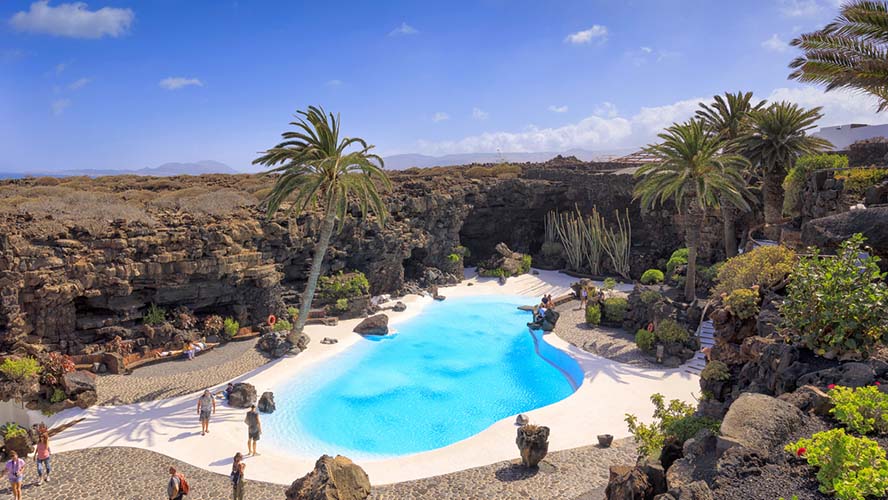
Plant life breaks through the basalt rock, and the place provides a home for tiny crabs. The space, designed as a Centre for Art, Culture and Tourism, contains a pool with whitewashed sides, an auditorium, and a centre specialising in vulcanology. The Jameos del Agua has some truly awe-inspiring features. These include a natural lake with clear waters, and a barrel vault, resembling a cathedral nave with a hole in the top which allows in what appears to be a remarkable beam of heavenly light.
The gardens are full of luxuriant vegetation. The palm, cactus and fig trees appear to watch over the undulating white swimming pool. The green of the plants, the pure white of the pool, the blueness of the water, and the blackness of the volcanic rock all contribute to a scene of great beauty. Anyone who has attended a concert in the Jameos del Agua auditorium, set within a volcanic cave, will know that this is a wonderful experience, thanks to the cave’s geological characteristics and its acoustic features.
Cueva de los Verdes, phenomena created by lava
The tunnel created by the eruption of the Volcán de la Corona, also contains the Cueva de los Verdes, located in the Haría district. This space has an illusory quality. It is a kind of labyrinth consisting of three vertically connected and interlinked galleries.In places, they reach a height of 50 metres.
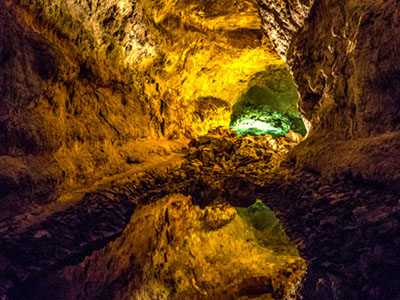
The quirky shapes formed by the lava come as a surprise to visitors to this remarkable corner of Lanzarote. The Cave is a pleasant place to visit, thanks to its stable temperature (around 19º C) and to the anecdotes told by the guides. They point out the most curious-looking stony structures, formations such as lava stalactites, and marks that show the levels reached by the river of fire. Among the highlights are the Auditorio [Auditorium], the Sala de las Estetas [Hall of the Aesthetes], Garganta de la Muerte [Throat of Death], and the Puerta Mora [Moorish Doorway].
In the past, the place provided a shelter for flocks belonging to the the Los Verdes family, who owned the land. This explains the name: La Cueva de los Verdes. And before that, in the sixteenth and seventeenth centuries, it was used as a hiding place during attacks by pirates from north Africa. It was only a century later that their geological importance was realised, and European scientists and intellectuals began to visit them, fascinated by such an extraordinary volcanic formation.
It started to become a tourist attraction for visitors to Lanzarote in 1964, when two kilometres of it were made accessible. From then onwards, it became part of the network of Lanzarote Island Council’s Centres of Art, Culture and Tourism. The present-day appearance of the Cueva de los Verdes is the work of the artist Jesús Soto who frequently collaborated with César Manrique. Visitors are struck by the use of light and shade to make the stone stand out, and to highlight the weird shapes left by the lava after the eruption and their various colours: shades of red, grey, black and ochre.
La Graciosa, the eighth Canary island
Anyone who has visited the island of La Graciosa will never forget the impact of the scene as the boat approaches the port. Ferries depart every thirty minutes from the port of Órzola in Lanzarote. The short crossing is a voyage in search of a dream. Because La Graciosa, the eighth populated island of the Canary archipelago, is a tiny piece of paradise. There is no asphalt anywhere on the island.Its streets of sand come as a surprise on arrival at Caleta de Sebo. That is when the clocks stop. Here, you can forget rushing around. Time stands still, and the visitor is transported away from the noisy city environment.
La Graciosa, located at the eastern end of the Canary archipelago, is a haven of peace with a population of under 1,000 inhabitants. Caleta del Sebo is the largest centre of population, followed by Pedro Barba, a hamlet with a mere handful of white cottages for people in search of privacy and tranquility.
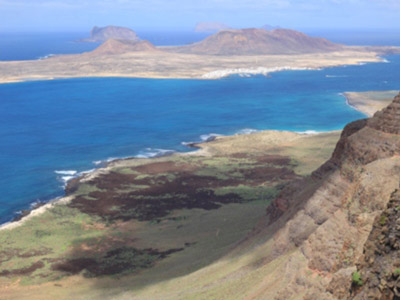
The landscape is dominated by the volcanoes of Las Agujas, El Mojón, Montaña Amarilla and Montaña Bermeja. And out at sea can be glimpsed the islets of Montaña Clara, Alegranza, Roque del Este, and Roque del Oeste. Everything in this setting with its hues of red, yellow and ochre seems designed to make us stand and stare. The island covers an area of 27 square kilometres, and makes a striking impression with its deserted beaches and fascinating volcanic landscapes. Whether on foot or by bicycle, the island offers scores of paths where you can wander amid the silence and beauty of its wild natural scenery.
Notable attractions include the diving centre, which is below sea level. The island is part of the Chinijo Archipelago Marine Reserve, the largest such reserve in Europe, which covers over 70,700 hectares and boasts the highest level of marine biodiversity in the Canary Islands. The Reserve also includes the uninhabited islands of Alegranza and Montaña Clara, which have magnificent beaches. These islands can be visited on one of the catamaran or boat excursions available in the area.
No stay on La Graciosa should omit a visit to the Montaña Amarilla [Yellow Mountain]. It can be reached either on foot or in a private vehicle. The volcano’s striking yellow colour contrasts with the blue of the sky and the turquoise of the sea, and is well worth a visit. Afterwards, you could go for a swim at Playa de la Francesa, a large stretch of white sand. At the end of the beach, a narrow path leads to Playa de la Cocina, an exquisite cove wedged into the very foot of Montaña Amarilla.
Equally spectacular is desolate Playa de Baja del Ganado on the northern coast. From this shore, where the sand mingles with the volcanic rock, we can enjoy a breathtaking view of the nearby island of Montaña Clara. Even further north lies Playa de las Conchas. This large, deserted beach is subject to strong ocean currents. Here it is easy to believe you’ve been shipwrecked on a desert island. Skirting the coast, we come face to face with one of the island of La Graciosa’s iconic sights: The Arcos de los Caletones — natural basalt arches formed by erosion from the sea that flows beneath. Nearby is Playa del Ámbar, hemmed in by sand dunes.
Mirador del Río [River Viewing Point] — looking out to the Chinijo Archipelago
The Mirador del Río, a creation by César Manrique, is one of the most special places on the island of Lanzarote. Its location on the summit of the Risco de Famara — a 22-kilometre-long mountain range — provides unique, panoramic views of the natural park of the Chinijo Archipelago. Manrique’s construction is on the Salinas del Río [salt flats], a remarkable sight because of the reddish hue they impart to the landscape.
As is usual with Manrique’s creations, the structure is integrated into its setting in a way that makes it almost invisible from the outside. Entry to the viewing point is via a passage flanked by niches housing traditional ceramics by the local craftsman, Juan Brito. The passage emerges in the heart of the building, the great central hall. The viewing point has a pleasant snack bar with spectacular windows that function as the ‘eyes of the viewing point’.
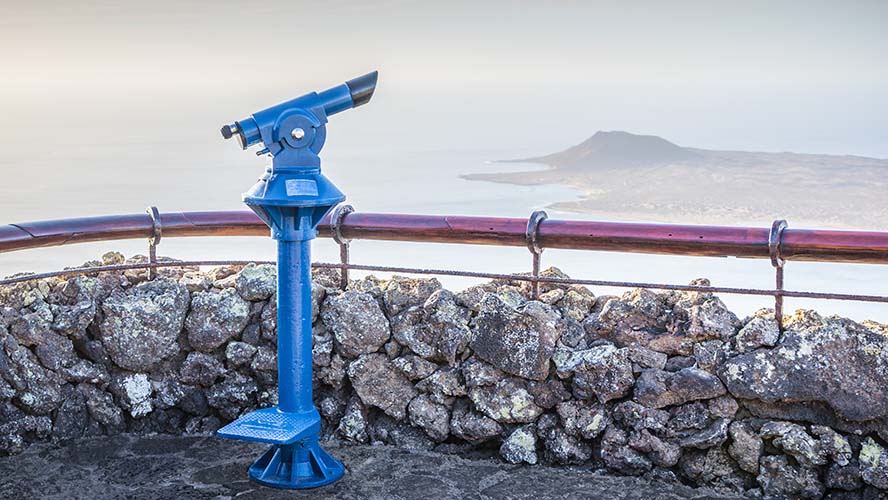
Through them, one can glimpse the collection of islets that make up the natural park of the Chinijo Archipelago, among which the island of La Graciosa stands out. In the foreground can be seen the stretch of sea that separates this small island from Lanzarote. This stretch is what the locals refer to as the ‘river’, the geographical feature that lends its name to the viewing point.
Jardín de Cactus [Cactus Garden], a place of great beauty
The Cactus Garden, Manrique’s last artistic installation on the island, is now one of Lanzarote’s most popular attractions. The garden houses a collection of around 4,500 specimens of cactus, made up of a total of 450 different species. However, the collection is still increasing, as new plants are gradually being added from across all the five continents. These include specimens originating from Madagascar, Peru and Tanzania, as well as cactus plants native to the Canary Islands themselves.
The remarkable diversity of the collection and, of course, César Manrique’s accomplished design have resulted in the attraction becoming an Asset of Cultural Interest in the Historic Gardens category. Like all this Canary Island artist’s pieces, the Cactus Garden is a complete work of art. It combines disciplines such as landscaping, architecture, painting and sculpture. Visitors to the garden find themselves in a place of remarkable beauty and tranquility.
The Cactus Garden’s structure was designed for dramatic effect, as it sets out to deliberately surprise the visitor. Entry to the attraction is via a curved opening which skirts around a sculpture in the centre. Having negotiated this bend, visitors can enjoy a panoramic view of the garden, and then make their way down the steps to see the vast cactus collection.
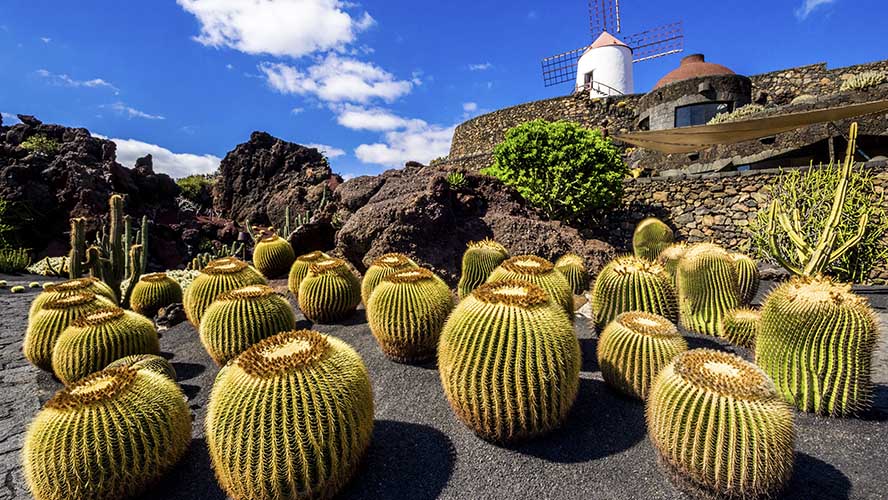
On the horizon beyond the Garden there looms the silhouette of a millet mill (maize is known as millet throughout the Canary Islands), of interest because it is one of the last remaining buildings of this type to be conserved on the island. The windmill dates from the early years of the nineteenth century, and was used in the production of gofio [toasted maize flour], a staple ingredient in the region’s cooking. The windmill commands one of the finest panoramic views of the area. Within the amphitheatre, two domed structures command the attention: these house the cafeteria and the Arts, Culture and Tourism Centre shop.
Los Hervideros, an astounding spectacle
Los Hervideros [The Cauldrons, in English], on Lanzarote’s south-western coast, is a group of extraordinary caves. Their appearance is the result of the lava spewed out by the volcanoes in the Timanfaya National Park between 1730 and 1736 coming into contact with the waters of the Atlantic Ocean. The strange shapes of the rocks here were caused by accelerated solidification and by constant erosion by the sea.
The location of Los Hervideros, halfway between the Salinas de Janubio [Janubio Salt Flats] and the coastal village of El Golfo, gives us an opportunity to admire the unrelenting onslaught of the waves, and to see how, as the water rebounds off the rocks, it creates a cloud that remains suspended in the air for a few moments. The seawater appears as if it is boiling, hence the descriptive name of the place — Los Hervideros, or The Cauldrons, in English. Water pours into the cavities opened up by the unstoppable advance of the lava, and provided that the force of the waves is strong enough, it gushes out through the overflow vents, i.e. through the openings scattered over the surface of the cliff.
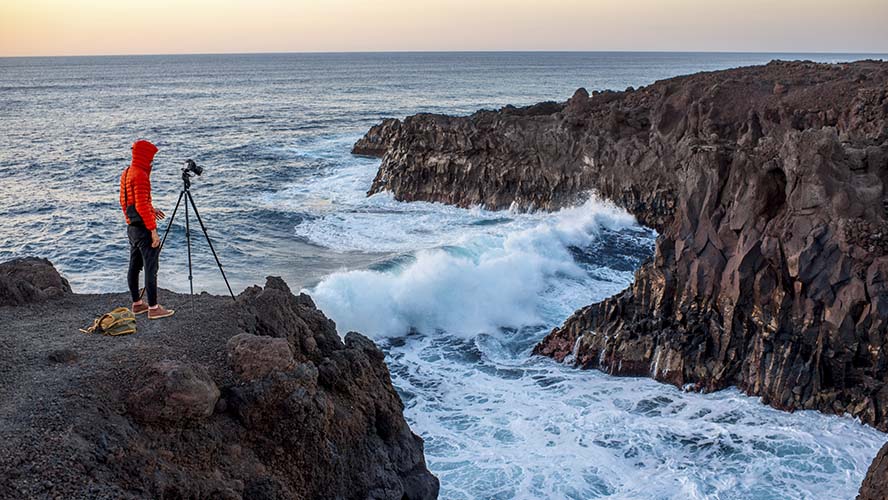
The spectacle is even more astonishing when the Atlantic is rough. But on a visit to the area, you need to follow the signs very carefully, keep to the paths marked out with stones, and climb up and down using the steps designed for that purpose. A series of artificial balconies has been created to enable visitors to feel the force of the ocean while they are inside. Although you will often see local fishermen who know the place well moving freely around areas that have not been adapted for visitors, you need to be extremely cautious, as the ground is uneven, and the furious power of the Atlantic is uncontrollable.
Fundación César Manrique, nature and culture
Everywhere on the island of Lanzarote, one finds reminders of César Manrique. Nature and culture, hand in hand. Creative risk-taking in harmony with the conservation of nature. Architecture and the volcanic spirit joining forces to produce a remarkable spectacle. A good part of the island is an open-air museum. Manrique had a vision, and he saw it through. His character, his work, and his activism in defence of the environment and against urban speculation have all become benchmarks for environmentalism throughout the world.
After a lengthy sojourn in the city of New York, the artist returned to his island, and began to turn his dream into reality. Inside a volcanic bubble in Tahíche, he built his first house, Taro, in the style of Lanzarote’s ancient stone buildings. The space continued to grow, and eventually became the Fundación César Manrique [César Manrique Foundation]. It opened in March 1992 — six months before the death of Manrique — and comprises the former residence, staff quarters and garages.
The building possesses some truly amazing features, including windows through which lava enters, thereby creating a connection between the building and the volcano — making it difficult to tell where one ends and the other starts. Similarly, the contrast between the blackness of the volcanic rock and the luminous white of the walls is present throughout the entire structure.
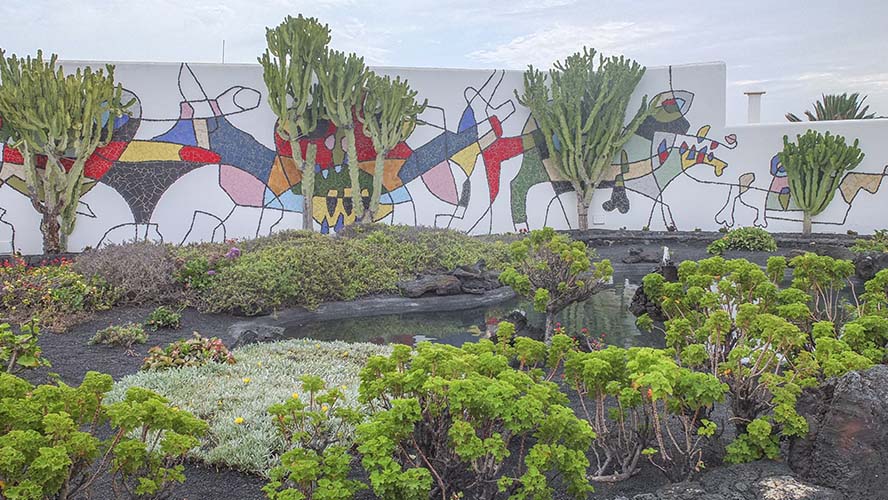
In areas such as the pool, we can see how the Canary Island architect adapted the volcanic lava to create a bridge. Outside, it is worth pausing to admire the mural designed between 1991 and 1992 by Manrique first tracing its design with volcanic rock, and then filling the spaces in between with tiles. The garden contains numerous varieties of palm trees and cacti.
The Foundation, an essential visit for anyone interested in the artist himself and his works, houses his collection of contemporary art. It includes works by Cuixart, Chirino, and the Equipo Crónica. The museum also houses a small collection of Canary Island art, as well as three further rooms of works by Manrique.
Visit Lanzarote’s most picturesque towns and villages
Teguise, a coastline that evokes memories of the Lanzarote of the past
Teguise is Lanzarote’s largest municipality. It stretches from the east to the west coast. The town of Teguise, protected in the past from pirates by Santa Bárbara Castle, lost its status as capital to a town with a port, Arrecife. This town, with its air of austere elegance, has an attractive historic quarter with white houses and charming squares.
The area’s outstanding attraction is its coast, which includes the Costa Teguise giant tourist complex. The Canary Island artist César Manrique was involved in the design of the complex. His concern for the sustainability of the tourism boom led him to strive to preserve the identity of the old Lanzarote in the project. Around what is known as the Pueblo Marinero — Manrique’s tribute to traditional Canary Island architecture — lie a multitude of open spaces, deluxe hotels and residential developments which recall seventies-style luxury. A golf course, a water park and an immense aquarium, along with the four natural beaches spread along the coastline, complete the area’s extensive range of leisure facilities.
Another, only slightly younger vestige is to be found at the Residencia Real de La Mareta, located on the sea shore on the outskirts of Costa Teguise. Its history dates back to the end of the 1970s. This is a luxurious building which originally belonged to King Hussein I of Jordan, who later gave it as a gift to King Juan Carlos I. For years, figures as diverse as the ex-head of the Soviet Union, Mikhail Gorbachev, and the ex-heads of the Spanish Government, José María Aznar and José Luis Rodríguez Zapatero, spent their summer holidays here. Today it forms part of the Canary Islands’ heritage.
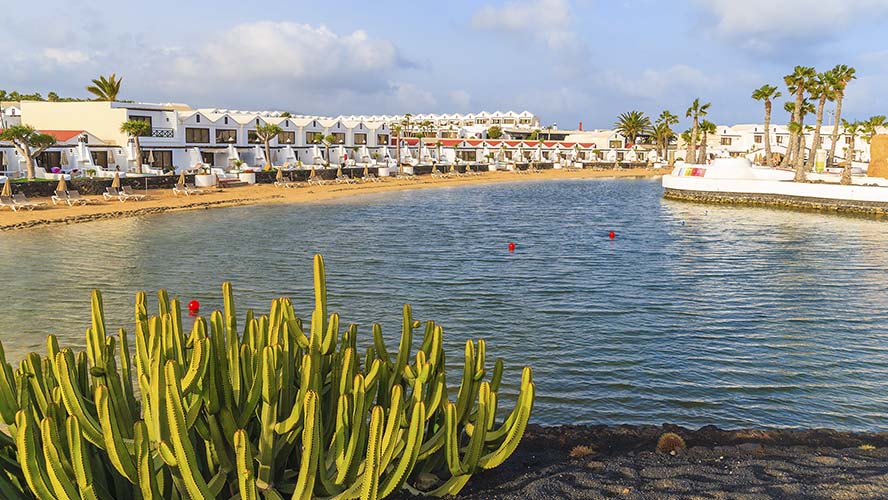
The area’s most outstanding beaches are Las Cucharas, Los Charcos and El Jablillo. Las Cucharas is the largest, and the only beach with fine, golden sands. It has several windsurfing schools, thanks to its ideal location for this sport. Los Charcos has white sands, while El Jabillo is the smallest and quietest of Costa Teguise’s beaches. It has breakwaters which, at low tide, form a kind of natural swimming pool on the beach. The area’s fourth beach is Playa Bastián, speckled with black by the presence of volcanic charcoal in the sand.
Costa Teguise offers a huge range of leisure and sports activities. Among the many places to visit is Aquapark Costa Teguise, Lanzarote’s largest water park. And the Lanzarote Aquarium, which is home to hundreds of different species.
Venturing further inland in this beautiful corner of the island, there are also the five amazing volcanic peaks of the Tahiche, Tinaguache, Corona, and Tejida mountains. Corona and Tinaguache are the nearest, and their moderate altitude (no greater than 230 metres) makes them accessible to every visitor. They have beautiful viewing points offering views of the Atlantic Ocean.
Haría, a bucolic setting
Haría is a picturesque little town in the centre of the Mil Palmeras valley. Lying in the shadow of the La Corona volcano, the town was the place chosen by César Manrique for his first workshop, in a refurbished farmhouse. In this remote, lost town in the north of the island, the artist and architect spent the last years of his life. He died in an accident in 1992. Nowadays, his home has been converted into a house-cum-museum, and is open to the public. After visiting here, it is worth taking a quiet stroll through the town.
Attractions to be found in Haría’s bucolic setting include lovely squares such as León y Castillo, where visitors can rest in the shade of the laurel and eucalyptus trees; the church of Nuestra Señora de la Encarnación, and the Ermita de San Juan Bautista [Hermitage of St. John the Baptist]. There is also a craft market which is very popular with locals and tourists alike. Another of the area’s highlights, on the narrow, winding road leading down to the town, is the viewing point, the Mirador de Haría. Manrique had a hand in its creation too, and even designed a little house for hikers.
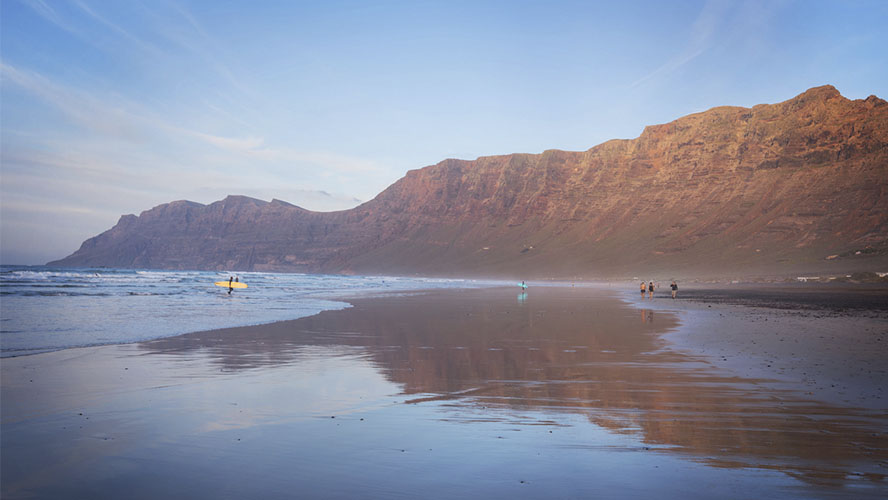
The viewing point, also known as the Mirador de Malpaso, is set among palm and dragon trees, in an area rich in farmland, beautiful landscapes, and geological features. From here, travellers can admire incomparable panoramic views of the municipality of Haría, with its groves of palm trees, its terraces and the coast in the distance.
La Geria, Lanzarote’s fine wines
The Valle de La Geria, a vast expanse of volcanic ash located in the south-west of the island, includes five of the seven municipalities that make up Lanzarote. This area, very close to the Timanfaya National Parkis, is well known for its wineries. The place highlights the astounding capacity of the conejeros [the inhabitants of Lanzarote] to adapt to their environment, as they came up with an ingenious cultivation method based on gerias — hollows in the ground — which has enabled the area to be a prolific producer of wine.
Row upon row, these perfect hollows, tinged with green, ochre and black, eventually traced a unique pattern over the land. With the passage of time, only the wineries and a few farm buildings now remain in La Geria, existing in perfect harmony in this landscape scattered with volcanic cones, lava fields, and mysterious caves. Lots of people are drawn to La Geria to visit one of the enormous number of wineries to be found along the LZ-30 — the unremarkable road that divides the valley.
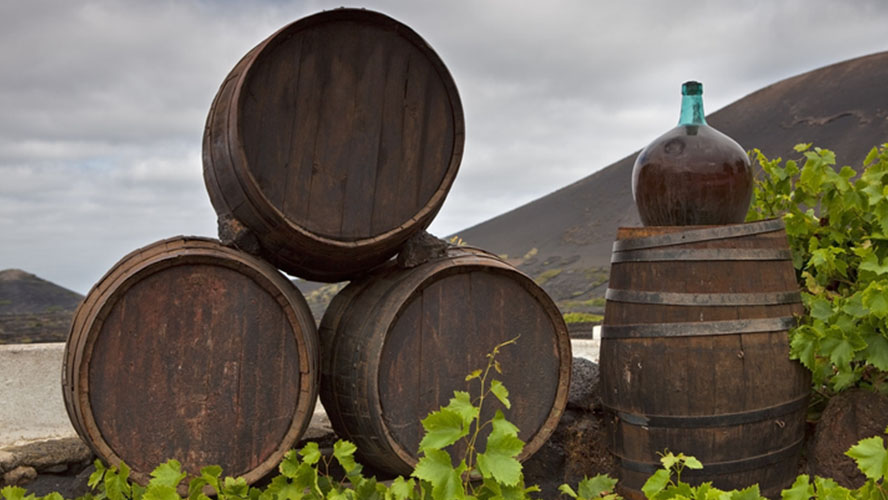
The vine plantations, in true Canary Island style, lend the area a dreamlike air. A real treat is enjoying a glass of malvasía, the island’s speciality, as you admire the scenery. Recognised in 1987 as a Protected Area, and in 1994 as a Protected Natural Space, the Valle de la Geria has also hosted since 2011 the Festival Sonidos Líquidos [Festival of Liquid Sounds]: a local initiative focused on promoting the local wine through alternative music concerts performed in the open air.
El Golfo and the Charco de los Clicos [Green Lagoon]
Also known as the Green Lagoon, the Charco de los Clicos is another unforgettable corner of Lanzarote. It is to be found in the little fishing village of El Golfo, at the south-western end of the Timanfaya National Park. The little bay, barely two minutes from the town, is like a scene from a dream, a vision of remote planets yet to be explored. In fact, this is the crater of a volcano which has been partly drowned by the ocean. The crescent-shaped bay on the opposite shore, with its beach of black sand and a lake of emerald-green waters (due to a high concentration of algae) is a beautiful but desolate sight, and has featured in both Spanish and international films.
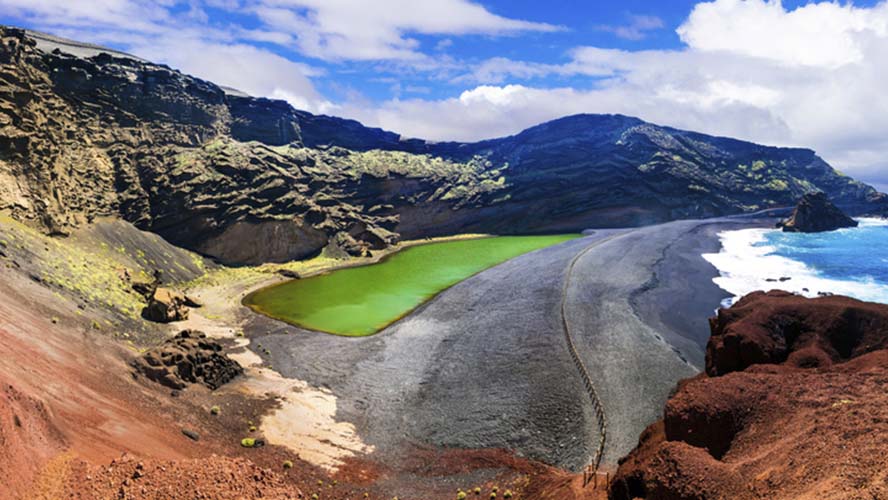
This mesmerising setting held a powerful appeal for Pedro Almodóvar. It was here that the director shot a series of romantic scenes starring Penélope Cruz and Lluís Homar, for his film Los abrazos rotos [Broken Embraces] (2009). Lovers of classic cinema will also remember Raquel Welch emerging from the green-coloured waters of a lake in a ‘prehistoric’ bikini. This scene, from the British film One Million Years B.C. (1966), set in the Paleolithic Age, was shot in this mysterious corner of Lanzarote.
Lanzarote’s beaches
Papagayo beach, the jewel of the South
Papagayo is the most popular beach in Punta del Papagayo, a secluded area in the far south of Lanzarote, within the Los Ajaches Natural Park. This is a protected area, and to access it there is a charge of three euros. A small price to pay in view of all the treasures held in this untamed area, full of unspoilt beaches. Here, the only signs of civilisation are a car park, a campsite and a couple of beach bars.
Papagayo beach has the typical perfect crescent shape, and is fully protected from the wind by cliffs. A small bay, its waters are particularly suitable for snorkelling. There are plenty of other idyllic bathing spots around the area: Playa Mujeres, Caleta del Congrio, Caletón de San Marcial, Playa de la Cera, Playa del Pozo, and Playa Puerto Muelas. Golden sands, limpid waters and gentle waves are a common denominator in all the beaches of this remote part of Lanzarote, so you can always find a quiet spot where you can be alone.
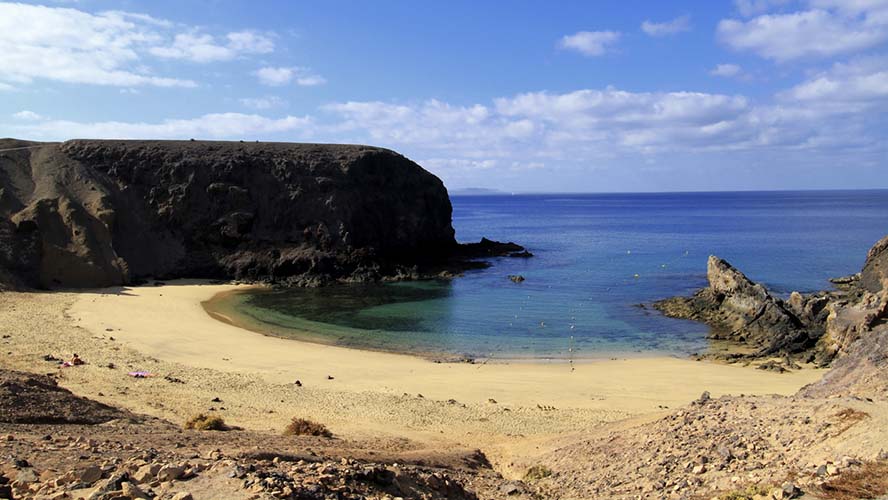
Playa de Famara
A typical beach with a beauty that words can scarcely do justice to. This is a wild space with fine, golden sands stretching for over five kilometres in the north-west of Lanzarote. The beach lies within the Chinijo Archipelago Natural Park, between the fishing village of La Caleta de Famara and the cliffs of the Risco de Famara. The winds and strong waves make this a perfect place for water sports such as surfing, bodyboarding, windsurfing, or kitesurfing. A wonder of nature.
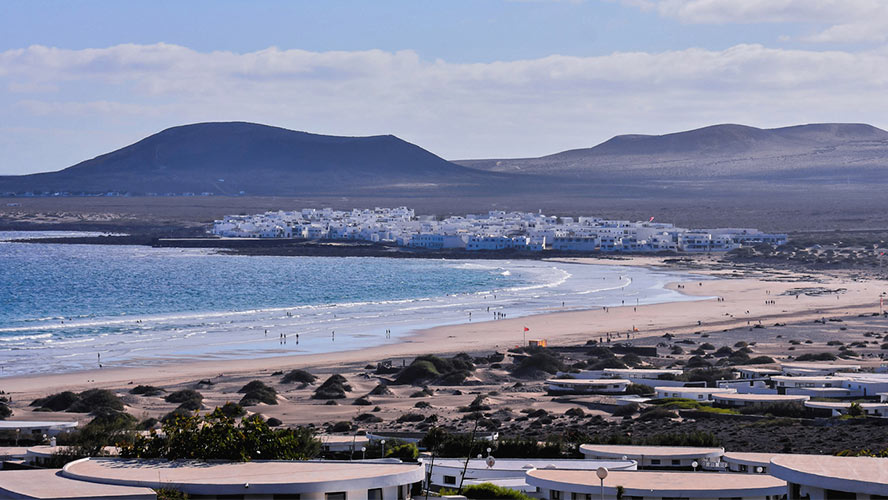
Playa de los Caletones
This beach, located near the coastal village of Órzola in the north of Lanzarote, is actually formed by a series of small coves. The place owes its rugged terrain to the remains of the famous Corona volcano, which lend it a unique and exotic appearance. The beach lies very close to Roque del Este and the islets of the Chinijo Archipelago. The beach can be accessed by car, and you can park nearby.
Playa del Pozo (Playa Quemada)
Playa Quemada is a fantastic spot, an incredibly beautiful sight in this part of south-eastern Lanzarote. Playa del Pozo is a small beach, barely 300 metres long, with pebbles and black sand. It is astoundingly beautiful and is normally deserted. The beach, which is difficult to access, lies near the Los Ajaches Natural Monument.
Playa Honda
This beach, with its golden sands and calm waters, belongs to the village of the same name, and lies close to the town of San Bartolomé. It is 1,300 metres long, and its semi-urban location tends to attract the crowds. It has a delightful path linking the area with Puerto del Carmen and Arrecife. It is not far from César Manrique Lanzarote Airport.
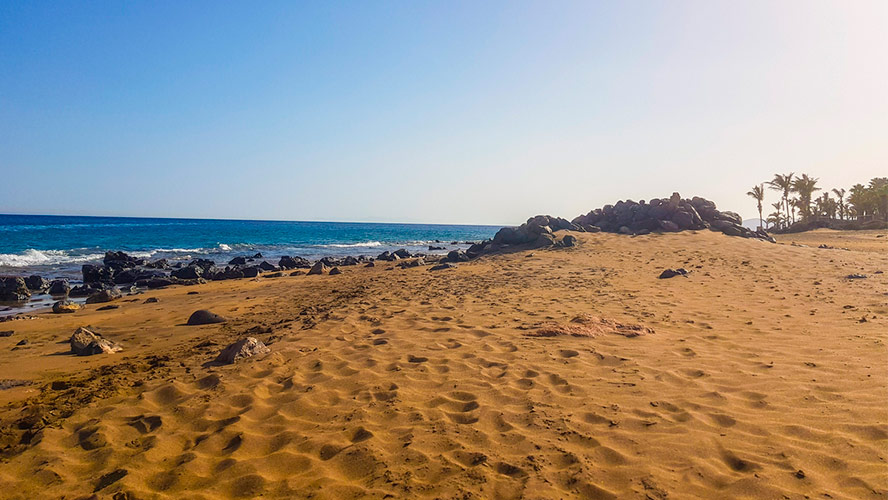
Playa del Janubio
This awe-inspiring, wild beach with black sands lies close to the town of Yaiza, and is a haven of peace and calm. It is around 800 metres long, but the currents are strong, making it unsuitable for swimming. It is very near the extraordinary Salinas de Janubio, Los Hervideros, Timanfaya, and Charco de los Clicos.
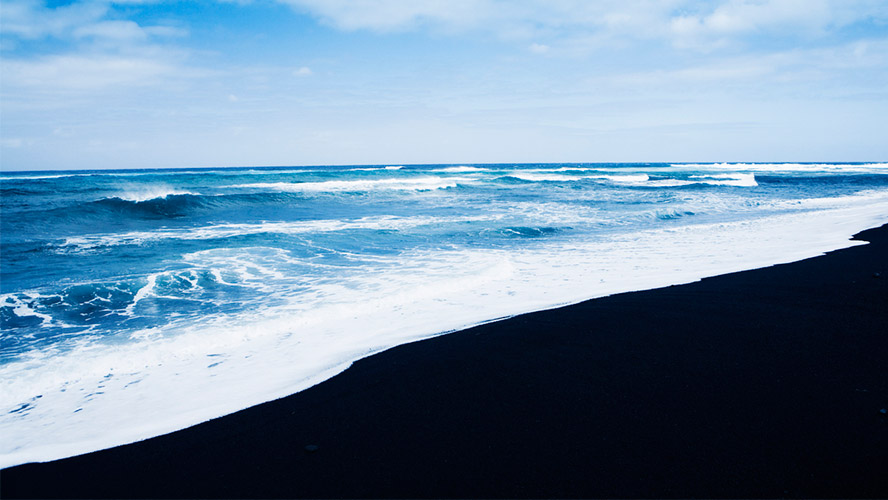
Playa El Ancla o Playa del Rey
Situated at the entrance to Costa Teguise from Arrecife, this small beach surrounded by rocks offers safe conditions for bathing and snorkelling. However, its small size (it stretches for barely 150 metres) means that it tends to get very crowded. It has golden sands and clear waters. The beach’s nickname — Playa del Rey [the King’s Beach] — results from its proximity to Las Maretas, a residence that once belonged to King Hussein of Jordan, and which he gave as a gift to ex-King Juan Carlos I.
Hoteles de Lanzarote
The best options for excellent accommodation on the island of Lanzarote are the Occidental Lanzarote Mar, Barceló Teguise Beach and Occidental Lanzarote Playa hotels.
The Occidental Lanzarote Mar Hotel. The Occidental Lanzarote Mar is a four-star hotel in Costa Teguise, one of Lanzarote’s most famous tourist resorts, about 6 kilometres from Arrecife. The hotel has 442 comfortable guest rooms designed so that guests can enjoy a pleasant holiday. In addition, the hotel has 3 adult swimming pools and 2 children’s pools, and offers a range of food and drink to suit all tastes. Sports enthusiasts will be delighted with the facilities available here: an Olympic-sized swimming pool, a professional cycling centre, a professional gymnasium, and a varied range of sports activities.
Barceló Teguise Beach-Adults Only Hotel. Designed exclusively for adults, the Barceló Teguise Beach-Adults Only Hotel stands on the beachfront at Costa Teguise, just 150 metres from Playa de Las Cucharas. It has 305 comfortable guest rooms with a décor inspired by local architecture. In addition to a great selection of bars and restaurants, the hotel has a superb wellness centre, two swimming pools and a gymnasium.
The Occidental Lanzarote Hotel. Situated close to El Ancla beach, in Costa Teguise, the Occidental Lanzarote Playa Hotel is the perfect place for a peaceful, enjoyable holiday. The hotel’s All-Inclusive package allows guests to benefit from the very best services: food and drink, sun loungers and towels for the swimming pool, direct access to the beach, etc. There is also an entertainment programme with evening shows, as well as fitness activities and team games.



























































